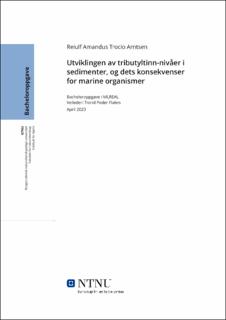| dc.contributor.advisor | Flaten, Trond Peder | |
| dc.contributor.author | Arntsen, Reiulf Amandus Trocio | |
| dc.date.accessioned | 2023-06-14T17:20:08Z | |
| dc.date.available | 2023-06-14T17:20:08Z | |
| dc.date.issued | 2023 | |
| dc.identifier | no.ntnu:inspera:146699659:64396297 | |
| dc.identifier.uri | https://hdl.handle.net/11250/3071430 | |
| dc.description.abstract | I denne oppgaven undersøkes det hvordan konsentrasjonen av tributyltinn (TBT) i sedimenter har endret seg etter at de ble forbudt å bruke som begroingshemmer for bunnstoff på båter av den internasjonale sjøfartsorganisasjonen (IMO) i 2008, samt hvilke konsekvenser dette har hatt for marine organismer. Dette gjøres ved først å presentere teori om hva organiske tinnforbindelser (OTF) og TBT er, forbindelsenes egenskaper og deres anvendelser i samfunnet i et historisk perspektiv. Deretter beskrives hovedkildene til forurensing av TBT. Teori om nedbrytningsprosessen vil belyse hvorfor forurensing av TBT fortsatt er et viktig miljøspørsmål sett i sammenheng med konsekvensene av TBT som hormonforstyrrende stoff. Konsekvensene TBT har for en rekke ulike grupper marine organismer presenteres sammen med virkningsmekanismene. Teorien vil deretter føre til en diskusjon der data fra en rekke artikler vil ses i sammenheng med relevant teori for å svare på spørsmålet i bachelorprosjektet. Dette er til slutt oppsummert i en konklusjon. | |
| dc.description.abstract | This thesis examines how the concentration of tributyltin (TBT) in sediments has changed after they were banned from being used as antifouling agents on boats by the International Maritime Organization (IMO) in 2008, as well as what consequences this has had for marine organisms. This is done by first presenting theory about what organic tin compounds (OTC) and TBT are, the properties of the compounds and their applications in a historical perspective. Next, the main sources of contamination by TBT are described. Theory about the degradation process will substantiate why contamination of TBT is still an important environmental issue seen in the context of the consequences of TBT as an endocrine disruptor. The consequences of TBT for a number of different groups of marine organisms are presented together with the mechanisms of action. The theory will then lead to a discussion where data from a number of articles will be discussed in connection with relevant theory to answer the aim in the bachelor's project. This is finally summarized in a conclusion. | |
| dc.language | nob | |
| dc.publisher | NTNU | |
| dc.title | Utviklingen av tributyltinn-nivåer i sedimenter, og dets konsekvenser for marine organismer | |
| dc.type | Bachelor thesis | |
